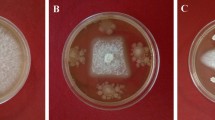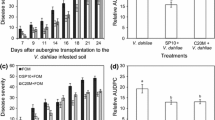Abstract
Two field experiments were conducted to evaluate the effect of organic fertilizer application either with or without antagonistic bacteria (Bacillus subtilis SQR-5 and Paenibacillus polymyxa SQR-21) on the control of Fusarium oxysporum f. sp. Cucumerinum J. H. Owen wilt disease in cucumber. The incidence of Fusarium wilt disease was 5.3–13.5% for cucumber plants treated with bioorganic fertilizer, while it was 30.3–51% in controls (only with organic fertilizer). Higher yields and lower disease incidences were observed in the dry season when compared with the wet season for both types of organic fertilizer treatments. Biolog analysis showed a significant change in soil bacterial composition and activity after bioorganic fertilizer application. The numbers of colony-forming units of F. oxysporum f. sp. Cucumerinum J. H. Owen for bioorganic-fertilizer-treated soils were significantly decreased compared with control. Scanning electron micrographs of cucumber basal stems showed a presence of mycelia-like mini strands accompanied by an amorphous substance within the xylem vessels. This amorphous substance and mini strands were richer in calcium and phosphorus but had low carbon and oxygen than the living mycelia. Reverse-phase high-pressure liquid chromatography and mass spectroscopic analysis showed that the antagonistic bacteria produced the antifungal compounds fusaricidin A, B, C, and D with molecular weights of 883.5, 897.5, 947.5, and 961.5 Da, respectively. The application of bioorganic fertilizer has a great potential for the control of F. oxysporum wilt disease in cucumber plants.





Similar content being viewed by others
References
Atlas RM (1995) Handbook of media for environmental microbiology. CRC, New York
Beatty PH, Jensen SE (2002) Paenibacillus polymyxa produces fusaricidin-type antifungal antibiotics active against Leptosphaeria maculans, the causative agent of blackleg disease of canola. Can J Microbiol 48:159–169
Benhamou N (1995) Ultrastructural and cytochemical aspects of the response of eggplant parenchyma cells contact with Verticillium-infected xylem vessels. Physiol Mol Plant P 46:321–338
Benhamou N, Joseph WK, Sadik T (1998) Induction of resistance against Fusarium wilt of tomato by combination of chitosan with an endophytic bacterial strain: ultrastructure and cytochemistry of the host response. Planta 204:153–168
Beyer M, Roding S, Ludewig A, Verreet JA (2004) Germination and survival of Fusarium graminearum macroconidia as affected by environmental factors. J Phytopathol 152:92–97
Bora T, Ozaktan H, Gore E, Aslan E (2004) Biological control of Fusarium oxysporum f. sp. melonis by wettable powder formulations of the two strains of Pseudomonas putida. J Phytopathol 152:471–475
De Cal A, Pascual S, Malgarejo P (1997) A rapid laboratory method for assessing the biological potential of Penicillium oxalicum against Fusarium wilt of tomato. Plant Pathol 46:699–707
Dimond AE, Waggoner PE (1953) On the nature and role of vivotoxins in plant disease. Phytopathology 43:229–235
El-Hassan SA, Gowen SR (2006) Formulation and delivery of the bacterial antagonist Bacillus subtilis for management of Lentil vascular wilt caused by Fusarium oxysporum f. sp. lentis. J Phytopathol 154:148–155
Filippi C, Bagnoli G, Treggi G, Picci G (1984) Antagonistic effects of soil bacteria on Fusarium oxysporum Schlecht f. sp.dianthii (Prill and Del.) Snyd. and Hans. Plant Soil 80:119–125
Filippi C, Bagnoli G, Volterrani M, Picci G (1987) Antagonistic effects of soil bacteria on Fusarium oxysporum Schlecht f. sp.dianthi (Prill and Del.) Snyd. and Hans. Plant Soil 98:161–167
Fridlender M, Inbar J, Chet I (1993) Biological control of soil-borne plant pathogens by a b-1, 3-glucanase-producing Pseudomonas cepacia. Soil Biol Biochem 25:1211–1221
Garber RH, Houston BR (1966) Penetration and development of Verticillium albo-atrum in the cotton plant. Phytopathology 56:1121–1126
Gracia-Grza JA, Fravel DR (1998) Effect of relative humidity on sporulation of Fusarium oxysporum in various formulations and effect of water on spore dispersal. Phytopathology 88:544–549
Gong M, Wang JD, Zhang J, Yang H, Lu XF, Pei Y, Cheng JQ (2006) Study of the antifungal ability of Bacillus subtilis strain PY-1 in vitro and identification of its antifungal substance (iturin A). Acta Biochim Biophys 38:233–240
Guetsky R, Shtienberg D, Elad Y, Dinoor A (2001) Combining biocontrol agents to reduce the variability of biological control. Phytopathology 91:621–627
Harish S, Manjula K, Podile AR (1998) Fusarium udum is resistant to the mycolytic activity of a biocontrol strain of Bacillus subtilis AF 1. FEMS Microbiol Ecol 25:385–390
Ito M, Koyama Y (1972) Jolipeptin, a new peptide antibiotic. Isolation, physico-chemical and biological characteristics. J Antibiot 25:304–308
Kajimura Y, Kaneda M (1996) Fusaricidin A, a new depsipeptide antibiotic produced by Bacillus polymyxa KT-8 taxonomy, fermentation, isolation, structure elucidation and biological activity. J Antibiot 49:129–135
Kajimura Y, Kaneda M (1997) Fusaricidins B, C and D, new depsipeptide antibiotics produced by Bacillus polymyxa KT-8, isolation, structure elucidation and biological activity. J Antibiot 50:220–228
Kokalis-Burelle N, Vavrina CS, Rosskopf EN, Shelby RA (2002) Field evaluation of plant growth-promoting Rhizobacteria amended transplant mixes and soil solarization for tomato and pepper production in Florida. Plant Soil 238:257–266
Komada H (1975) Development of a selective medium for quantitative isolation of Fusarium oxysporum from natural soil. Rev Plant Protect Res 8:114–125
Koumoutsi A, Xiao-Hua Chen, Henne A, Liesegang H, Hitzeroth G, Franke P, Vater J, Borriss R (2004) Structural and functional characterization of gene clusters directing nonribosomal synthesis of bioactive cyclic lipopeptides in Bacillus amyloliquefaciens strain FZB42. J. Bacterial 186:1084–1096
Kurusu K, Ohba K, Arai T, Fukushima K (1987) New peptide antibiotics LI-FO3, FO4, FO5, FO7, and FO8, produced by Bacillus polymyxa I. Isolation and characterization. J Antibiot 40:1506–1514
Leifert C, Li H, Chidburee S, Hampson S, Workman S, Siqee D, Epton HA, Harbour A (1995) Antibiotic production and biocontrol activity by Bacillus subtilis CL27 and Bacillus pumilus CL45. J Appl Bacteriol 78:97–108
Lemanceau P, Alabouvette C (1991) Biological control of Fusarium diseases by fluorescent Pseudomonas and non-pathogenic Fusarium. Crop Prot 10:279–286
Lemanceau P, Alabouvette C (1993) Suppression of Fusarium wilts by fluorescent Pseudomonads: mechanisms and applications. Biocontrol Sci Technol 3:219–234
Marjan de B, Peter B, Frodo K, Joost JBK et al (2003) Control of Fusarium wilt of radish by combining Pseudomonas putida strains that have different disease-suppressive mechanisms. Phytopathology 93:626–632
Minuto A, Minuto G, Migheli Q, Mocioni M, Gullino ML (1997) Effect of antagonistic Fusarium spp. and of different commercial biofungicide formulations on Fusarium wilt of basil (Ocimum basilicum L.). Crop Prot 16:765–769
Minuto A, Spadaro D, Garibaldi A, Gullino ML (2006) Control of soilborne pathogens of tomato using a commercial formulation of Streptomyces griseoviridis and solarization. Crop Prot 25:468–475
Monni S, Bücking H, Kottke I (2002) Ultrastructural element localization by EDXS in Empetrum nigrum. Micron 33:339–351
Nannipieri P, Ascher J, Ceccherini MT, Landi L, Pietramellara G, Renella G (2003) Microbial diversity and soil functions. Eur J Soil Sci 54:655–670
Omar I, O'Neill TM, Rossall S (2006) Biological control of Fusarium crown and root rot of tomato with antagonistic bacteria and integrated control when combined with the fungicide carbendazim. Plant Pathol 55:92–99
Orwa JA, Govaerts C, Gevers K, Roets E, Van Schepdael A, Hoogmartens J (2002) Study of the stability of polymyxins B1, E1 and E2 in aqueous solution using liquid chromatography and mass spectrometry. J Pharm Biomed Anal 29:203–212
Paulus H, Gray E (1964) The biosynthesis of polymyxin B by growing cultures of Bacillus polymyxa. J Biol Chem 239:865–871
Pedersen BS, Mills NJ (2004) Single vs. multiple introduction in biological control: the roles of parasitoid efficiency, antagonism and niche overlap. J Appl Ecol 41:973–984
Pichard B, Larue JP, Thouvenot D (1995) Gavaserin and saltavalin, new peptide antibiotics produced by Bacillus polymyxa. FEMS Microbiol Lett 133:215–218
Piuri M, Sanchez-Rivas C, Ruzal SM (1998) A novel antimicrobial activity of a Paenibacillus polymyxa strain isolated form regional fermented sausages. Lett Appl Microbiol 27:9–13
Smith GE (1957) Inhibition of Fusarium oxysporum f. sp. lycopersici by a species of Micromonospora isolated from tomato. Phytopathology 47:429–432
Thirup L, Johansen A, Winding A (2003) Microbial succession in the rhizosphere of live and decomposing barley roots as affected by the antagonistic strain Pseudomonas fluorescens DR54-BN14 or the fungicide imazalil. FEMS Microbiol Ecol 43:383–392
Walker R, Powell AA, Seddon B (1998) Bacillus isolates from the spermosphere of peas and dwarf French beans with antifungal activity against Botrytis cinerea and Pythium species. J Appl Microbiol 84:791–801
Yang CH, Crowley DE, Menge JA (2001) 16S rDNA fingerprinting of rhizosphere bacterial communities associated with healthy and Phytophthora infected avocado roots. FEMS Microbiol Ecol 35:129–136
Ye SF, Yu JQ, Peng YH, Zheng JH, Zou LY (2004) Incidence of Fusarium wilt in Cucumis sativus L. is promoted by cinnamic acid, an autotoxin in root exudates. Plant Soil 263:143–150
Zhou T, Paulitz C (1994) Induced resistance in the biocontrol of Pythiu aphanidermatum by Pseudomonas spp. on cucumber. J Phytopathol 142:51–63
Zuber P, Nakano MM, Marahiel MA (1993) Peptide antibiotics. In: Sonenshein, Hoch JA, Losick R (eds) Bacillus subtilis and other Gram-positive bacteria. American Society for Microbiology, Washington, DC, pp 897–916
Acknowledgment
This research work was financially supported by China Science and Technology Ministry, 973 Program (2007CB109304) and 863 Program (2006AAD10Z416), China Agriculture Ministry (2006-G62), and ZJNSF (Y305679). We thank Professor Warren Dick at Ohio State University and Dr Tony Miller for their suggestions and English editing of the paper.
Author information
Authors and Affiliations
Corresponding author
Rights and permissions
About this article
Cite this article
Zhang, S., Raza, W., Yang, X. et al. Control of Fusarium wilt disease of cucumber plants with the application of a bioorganic fertilizer. Biol Fertil Soils 44, 1073–1080 (2008). https://doi.org/10.1007/s00374-008-0296-0
Received:
Revised:
Accepted:
Published:
Issue Date:
DOI: https://doi.org/10.1007/s00374-008-0296-0




